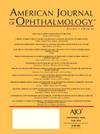Aravind假性脱落研究(APEX): 10年术后结果。
IF 4.1
1区 医学
Q1 OPHTHALMOLOGY
引用次数: 0
摘要
目的比较合并和不合并假性剥脱(PEX)的白内障术后术后长期(10年)最佳矫正视力(BCVA)和术后后囊膜混浊(PCO) Nd:YAG囊切除术的并发症发生率。设计采用随机对照试验数据的临床队列研究。受试者和对照组:930只患有白内障和假性角膜脱落的眼睛,没有白内障,临床上前房浅,或瞳孔小于4mm; 476只患有白内障但没有假性角膜脱落的对照组。方法将两组患者分别随机分为单片人工晶状体和3片人工晶状体。我们进一步将假性去角质组随机分为接受或不接受囊膜张力环。我们使用经验丰富的外科医生对所有眼睛进行超声乳化术并植入人工晶状体(IOL),随访时间为1天、1个月、3个月、1年,此后随访10年。主要观察指标:假性脱落与人工晶状体脱位、后囊膜混浊(需要切开后囊膜)和最佳矫正视力的关系。结果PEX组10年随访率为82.2%,对照组10年随访率为85.6%。竣工前死亡分别为24.1%和16.8%。PEX组和对照组的IOL脱位率(分别为2.4%和1.7%,p=0.4)和Nd:YAG囊膜切开率(分别为5.7%和5.67%,p=0.98)相似。晶状体囊包状(p=0.001)和囊裂未与晶状体晶状体边缘重叠(p<0.001)是晶状体脱位和Nd:YAG囊切开术的危险因素。10年时,对照组的logMAR BCVA优于PEX组(分别为0.08 vs 0.12;p = 0.035)。荚膜包茎(p=0.001)和囊裂未与人工晶状体重叠(p<0.001)均独立与晶状体脱位相关,需要进行囊切开术。结论:本研究是唯一一项长期、大规模、前瞻性的比较研究,由经验丰富的外科医生对PEX患者术前和术中无睫状体无力和小瞳孔的cor和IOL类型进行评估。在术后10年(大部分预期寿命),我们发现有和没有复杂PEX的眼睛与有1片或3片iol或cr的眼睛之间没有差异。本文章由计算机程序翻译,如有差异,请以英文原文为准。
Aravind Pseudoexfoliation Study (APEX): 10 Year Postoperative Results.
PURPOSE
To compare long-term (10-year) best corrected visual acuity (BCVA) and complication rates of intraocular lens (IOL) decentration and Nd:YAG capsulotomy for posterior capsule opacification (PCO) in eyes with and without pseudoexfoliation (PEX) after undergoing cataract surgery.
DESIGN
Clinical cohort study using RCT data.
SUBJECTS AND CONTROLS
Nine hundred thirty eyes with cataract and pseudoexfoliation without phacodonesis, clinically shallow anterior chambers, or pupil size <4 mm and 476 controls with cataract but without pseudoexfoliation.
METHODS
We randomized both groups separately to receive either a single-piece acrylic IOL or a 3-piece acrylic IOL. We further randomized the pseudoexfoliation group to receive or not receive capsular tension rings. We performed phacoemulsification using experienced surgeons with the insertion of an (IOL) on all eyes and we followed all at 1 day, 1 month, 3 months, 1 year, and yearly thereafter for 10 years.
MAIN OUTCOME MEASURES
The association of pseudoexfoliation with IOL decentration, posterior capsular opacification requiring capsulotomy, and best corrected visual acuity.
RESULTS
The 10-year follow-up was 82.2% for the PEX group and 85.6% in the control group excluding those who died in the interim. 24.1% and 16.8% respectively died before completion. IOL decentration rates (2.4% vs 1.7%, respectively, p=0.4) and Nd:YAG capsulotomy rates (5.7% vs 5.67%, respectively, p=0.98) were similar in PEX and control groups. Capsular phimosis (p=0.001) and capsulorhexis that did not overlap the edge of the IOL optic (p<0.001) were risk factors for IOL decentration and Nd:YAG capsulotomy. At 10 years, logMAR BCVA was better in the control than the PEX group (0.08 vs 0.12 respectively; p=0.035). Capsular phimosis (p=0.001) and a capsulorhexis that did not overlap the IOLs optic (p<0.001) were each independently associated with decentration and need for a capsulotomy.
CONCLUSIONS
This is the only long-term large-scale prospective comparative study using experienced surgeons evaluating both CTRs and IOL types in eyes with PEX, without preoperative and intraoperative zonular weakness and small pupils. At 10 years post-operative (most of a life expectancy) we found no differences between eyes with and without uncomplicated PEX and having either 1- or 3-piece IOLs, or CTRs.
求助全文
通过发布文献求助,成功后即可免费获取论文全文。
去求助
来源期刊
CiteScore
9.20
自引率
7.10%
发文量
406
审稿时长
36 days
期刊介绍:
The American Journal of Ophthalmology is a peer-reviewed, scientific publication that welcomes the submission of original, previously unpublished manuscripts directed to ophthalmologists and visual science specialists describing clinical investigations, clinical observations, and clinically relevant laboratory investigations. Published monthly since 1884, the full text of the American Journal of Ophthalmology and supplementary material are also presented online at www.AJO.com and on ScienceDirect.
The American Journal of Ophthalmology publishes Full-Length Articles, Perspectives, Editorials, Correspondences, Books Reports and Announcements. Brief Reports and Case Reports are no longer published. We recommend submitting Brief Reports and Case Reports to our companion publication, the American Journal of Ophthalmology Case Reports.
Manuscripts are accepted with the understanding that they have not been and will not be published elsewhere substantially in any format, and that there are no ethical problems with the content or data collection. Authors may be requested to produce the data upon which the manuscript is based and to answer expeditiously any questions about the manuscript or its authors.

 求助内容:
求助内容: 应助结果提醒方式:
应助结果提醒方式:


